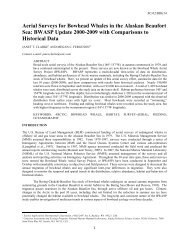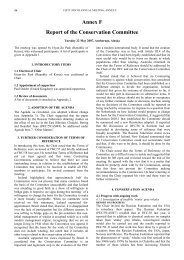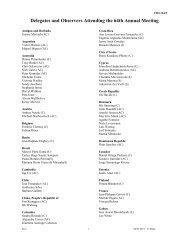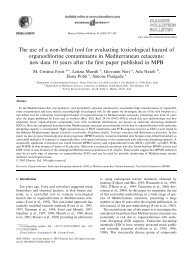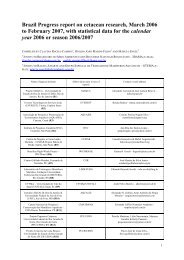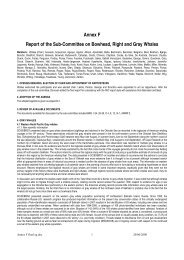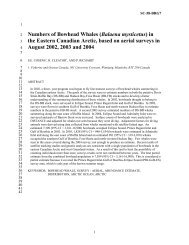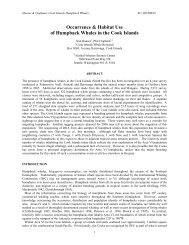First International Conference on Marine Mammal Protected Areas
First International Conference on Marine Mammal Protected Areas
First International Conference on Marine Mammal Protected Areas
Create successful ePaper yourself
Turn your PDF publications into a flip-book with our unique Google optimized e-Paper software.
SC/61/O20<br />
Executive Summary: <str<strong>on</strong>g>First</str<strong>on</strong>g> <str<strong>on</strong>g>Internati<strong>on</strong>al</str<strong>on</strong>g> <str<strong>on</strong>g>C<strong>on</strong>ference</str<strong>on</strong>g> <strong>on</strong><br />
<strong>Marine</strong> <strong>Mammal</strong> <strong>Protected</strong> <strong>Areas</strong> (ICMMPA)<br />
ERICH HOYT 1 , ON BEHALF OF THE ICMMPA STEERING COMMITTEE (SEE APPENDIX A)<br />
1 Whale and Dolphin C<strong>on</strong>servati<strong>on</strong> Society<br />
From March 30—April 3, 2009, more than 200 marine mammal protected area (MMPA) researchers, managers,<br />
and representatives from various government departments and c<strong>on</strong>servati<strong>on</strong> groups from 40 countries met in<br />
Maui, Hawaii, to explore how they might build networks of people, instituti<strong>on</strong>s and protected areas to further the<br />
c<strong>on</strong>servati<strong>on</strong> of marine mammals and their habitat.<br />
The overall c<strong>on</strong>ference theme of “networks: making c<strong>on</strong>necti<strong>on</strong>s” was explored in three c<strong>on</strong>ference threads<br />
focusing <strong>on</strong> (1) design, (2) management and (3) networking for the future of MMPAs and MMPA networks.<br />
These thematic strands were realized through a combinati<strong>on</strong> of talks and panels in a plenary symposium,<br />
followed by workshops, training sessi<strong>on</strong>s, posters and films.<br />
The first symposium thread <strong>on</strong> design of MMPAs and MMPA networks established that there were a growing<br />
number of MMPAs but that their effective coverage of important or critical habitat remains slight. There are a<br />
few marine mammal networks in the early stages of development, including a sister sanctuary relati<strong>on</strong>ship<br />
between the US and the Dominican Republic for humpback feeding and breeding areas, but the network<br />
possibilities remain largely unrealized. There are substantial benefits in terms of exchange of knowledge and<br />
resources, as well as providing better protecti<strong>on</strong> for marine mammals. Engagement is also needed with the larger<br />
MPA community at the regi<strong>on</strong>al, nati<strong>on</strong>al and internati<strong>on</strong>al level.<br />
In terms of management, many MPAs have been slow to set up effective management plans with m<strong>on</strong>itoring<br />
regimes. To be effective, management must be c<strong>on</strong>tinuous, science-based, incorporating ecosystem-based<br />
management as well as socioec<strong>on</strong>omic c<strong>on</strong>cerns and larger envir<strong>on</strong>mental issues, particularly fisheries, and<br />
include public participati<strong>on</strong> with educati<strong>on</strong>al programs. However, the difficulties are c<strong>on</strong>siderable if political will<br />
cannot be cultivated. Many management approaches have been tried and can be evaluated and shared, including<br />
time-area closures, permitting/licensing mechanisms, targeted research, and various educati<strong>on</strong>al tools. Strategies<br />
for ensuring funding and achieving success <strong>on</strong> a low budget are equally important. C<strong>on</strong>siderable energy was<br />
devoted to measuring management effectiveness. Adaptive management is c<strong>on</strong>sidered an important tool but<br />
MMPAs should still be established with the best possible management from the beginning.<br />
The third strand looked to the future and included, am<strong>on</strong>g other things, newer approaches for mobile MMPAs<br />
based <strong>on</strong> m<strong>on</strong>itoring dynamic and ephemeral ocean systems as well as discussi<strong>on</strong> of ocean z<strong>on</strong>ing outside<br />
MMPA networks which becomes more important with accelerating exploitati<strong>on</strong> of pelagic waters and the high<br />
seas. Regi<strong>on</strong>al scale spatial management, using comprehensive ocean z<strong>on</strong>ing, could help address threats<br />
throughout the extensive range of marine mammals. Protecting marine mammals as umbrella species can result<br />
in c<strong>on</strong>servati<strong>on</strong> measures to protect whole communities and ecosystems, and as such can be seen as investments<br />
in maintaining marine biodiversity and ocean health, but this can <strong>on</strong>ly work if threats are adequately understood<br />
and if management is truly tailored to the threats. In the brave new world of ocean z<strong>on</strong>ing, the focus should<br />
remain <strong>on</strong> threats, and not revert to cookie-cutter approaches to MPAs, in the hope that they will solve every<br />
c<strong>on</strong>servati<strong>on</strong> problem. This c<strong>on</strong>siderati<strong>on</strong> of marine mammals leading to broad c<strong>on</strong>servati<strong>on</strong> measures provided<br />
an added-value to the ICMMPA which transcended the discussi<strong>on</strong>s of marine mammal protecti<strong>on</strong> al<strong>on</strong>e.<br />
The high seas were touched <strong>on</strong> in various presentati<strong>on</strong>s in terms of design, management, legal aspects and<br />
incorporati<strong>on</strong> into networks. Representing about half of the world ocean, the high seas provide habitat for many<br />
marine mammal species, though this area, due to its distance from land is much less studied than coastal and<br />
nearshore areas. The legal framework for setting up MPAs <strong>on</strong> the high seas has a str<strong>on</strong>g foundati<strong>on</strong> and has<br />
advanced c<strong>on</strong>siderably but with <strong>on</strong>ly a few excepti<strong>on</strong>s has yet to be tried and fully tested. Over the next 2 years,<br />
the IUCN WCPA High Seas Task Force, the RAC/SPA in the Mediterranean and other regi<strong>on</strong>al scientific and<br />
c<strong>on</strong>servati<strong>on</strong> bodies plan to propose MPA networks <strong>on</strong> the high seas, so marine mammal critical habitat research<br />
will be essential. The ICMMPA is c<strong>on</strong>sidering to make the “High Seas” as the theme for the next c<strong>on</strong>ference<br />
proposed for France in 2012.<br />
1
SC/61/O20<br />
MPA designers, planners and managers must c<strong>on</strong>tinue to engage stakeholders, indigenous peoples, and the<br />
public through partnership, c<strong>on</strong>sultati<strong>on</strong>, educati<strong>on</strong> and outreach to build c<strong>on</strong>stituencies of support for MPA<br />
networks. There is great potential in incorporating cultural practices (indigenous, historical and modern) in<br />
planning and managing MPAs. It is important that costs and benefits be distributed fairly am<strong>on</strong>g stakeholders.<br />
It was recognized that there are various elements that can lead to the formati<strong>on</strong> of MMPA networks, including:<br />
• legal obligati<strong>on</strong>s created from regi<strong>on</strong>al or global agreements (eg, the Barcel<strong>on</strong>a and Cartegena<br />
c<strong>on</strong>venti<strong>on</strong>s),<br />
• marine mammals migrating across various jurisdicti<strong>on</strong>s (eg, the Latin American cetacean network)<br />
• requirements under nati<strong>on</strong>al policies (eg, New Zealand)<br />
• the need for standardized m<strong>on</strong>itoring throughout a species' range (eg, US nati<strong>on</strong>al marine sanctuaries)<br />
• the desire to gather data to support a comm<strong>on</strong> decisi<strong>on</strong> (eg, support for sanctuaries within the IWC)<br />
• critical habitat protecti<strong>on</strong> (eg, 33 sites identified in Mexico)<br />
• creating sister MPAs to share expertise and less<strong>on</strong>s learned, and<br />
• fulfilling the desire to c<strong>on</strong>nect people and instituti<strong>on</strong>s.<br />
In additi<strong>on</strong> to the symposium, workshops focused <strong>on</strong> criteria and mapping for critical habitat areas, getting<br />
stakeholders to talk to each other, exploring the role of culture in managing MMPAs, and creating regulati<strong>on</strong>s<br />
that work.<br />
A special workshop and several talks were also devoted to m<strong>on</strong>k seal c<strong>on</strong>servati<strong>on</strong>. The c<strong>on</strong>ference was<br />
fortunate to have a critical mass of the world’s m<strong>on</strong>k seal experts with problems and good c<strong>on</strong>servati<strong>on</strong><br />
outcomes that could be shared from the Mediterranean, West Africa and Hawaii.<br />
Training sessi<strong>on</strong>s covered marine mammal stranding, entanglement and health assessments, m<strong>on</strong>itoring MMPAs<br />
(check-up and review), management planning, naturalist training and the role of educati<strong>on</strong> in the community and<br />
<strong>on</strong> the water.<br />
The locati<strong>on</strong> of the c<strong>on</strong>ference in the middle of the Pacific was timely and appropriate. In January, the US had<br />
designated 3 new large MPAs in its Pacific territories and over the past few years, the number and size of MPAs<br />
had increased dramatically. To date, 7 of the 8 largest MPAs in the world are in the Pacific, and 11 of the top 15.<br />
In terms of highly protected, IUCN Category I areas, the area includes 4 of these, am<strong>on</strong>g the most highly<br />
protected MPAs in the world. It was recognized that the Hawaiian Islands Humpback Whale Nati<strong>on</strong>al <strong>Marine</strong><br />
Sanctuary (HIHWNMS), the host and locati<strong>on</strong> of the c<strong>on</strong>ference, had been a pi<strong>on</strong>eer MPA in the regi<strong>on</strong> and<br />
partly through its efforts with the collaborative internati<strong>on</strong>al SPLASH program (Structure of Populati<strong>on</strong>s, Levels<br />
of Abundance and Status of Humpbacks) and SPWRC (South Pacific Whale Research C<strong>on</strong>sortium), had<br />
c<strong>on</strong>tributed to the impetus for the c<strong>on</strong>ference and for the idea of solidifying and improving nascent networks in<br />
the Pacific.<br />
Key recommendati<strong>on</strong>s, statements and comments emerging from the c<strong>on</strong>ference were as follows:<br />
• The attendees valued the opportunity to have a forum to address and discuss their shared challenges and<br />
successes.<br />
• As part of networking, a str<strong>on</strong>g effort should be made to transfer essential skills, resources and capacity<br />
building to researchers and management staff in less developed countries to help them obtain the data<br />
necessary to develop and effectively manage MMPAs. A website with extensive resources and<br />
mentoring c<strong>on</strong>tacts should be set up as part of this, and teams of experts in the various aspects of<br />
MMPAs and network building could visit sites in order to teach and help measure effectiveness.<br />
• An urgent worldwide effort must be made to identify and define important marine mammal habitats and<br />
hot spots. Then this informati<strong>on</strong> must be mapped with other species and eco-geographic data to assist in<br />
the design and creati<strong>on</strong> of MPA networks in nati<strong>on</strong>al waters and <strong>on</strong> the high seas, working through<br />
nati<strong>on</strong>al governments as well as various regi<strong>on</strong>al and internati<strong>on</strong>al fora. Critical habitat is not defined<br />
simply as high density areas. Less dense areas may be more critical to survival depending <strong>on</strong> behavior<br />
and populati<strong>on</strong>/stock structure and if threats are present in these areas that impact the populati<strong>on</strong>.<br />
Therefore not <strong>on</strong>ly critical habitat but threats and all other human uses must be mapped.<br />
• The use of global databases covering envir<strong>on</strong>mental, oceanographic and marine species may assist<br />
progress in the identificati<strong>on</strong> of critical habitat and implementati<strong>on</strong> of MPAs, but it needs to be<br />
“ground-truthed” against more local data and/or through an expert body using, for example, a Delphic<br />
process to arrive at proposed MPAs.<br />
2
SC/61/O20<br />
• Threats to species and habitats may occur outside of an MPA, so it is important to look “outside the<br />
box”. It may be possible for MMPAs to act as catalysts, partners or support for regi<strong>on</strong>al, nati<strong>on</strong>al and<br />
internati<strong>on</strong>al impact research and mitigati<strong>on</strong> strategies.<br />
• Bycatch is a key threat to marine mammals worldwide. If fishery regulati<strong>on</strong>s do not solve the problem<br />
of entanglements, MMPAs with no fishing z<strong>on</strong>es could be alternatives to regular fishery management.<br />
• For management, advisory councils are a strategy for effectively engaging stakeholders. Expert<br />
advisory groups can help ensure appropriate scientific expertise for designing research and m<strong>on</strong>itoring<br />
projects.<br />
• More attenti<strong>on</strong> must be devoted to management plans: developing and updating them to make them<br />
more effective and sharing “best practices” to guide future work, as well as developing effective<br />
methodologies for evaluati<strong>on</strong>, and then sharing successes and failures in terms of measuring<br />
management effectiveness.<br />
• Guidance needs to be developed to integrate traditi<strong>on</strong>al marine management tools and the use of<br />
MMPAs/MMPA networks for c<strong>on</strong>servati<strong>on</strong>: which is best when, and when to use both<br />
• In terms of advocating for MMPAs and levels of protecti<strong>on</strong> and z<strong>on</strong>ing, marine mammal scientists<br />
should endeavor to present trade-offs and choices, so that decisi<strong>on</strong> makers can evaluate opti<strong>on</strong>s (rather<br />
than forcing scientists to become advocates).<br />
• The <str<strong>on</strong>g>C<strong>on</strong>ference</str<strong>on</strong>g> supported the research goals and, in particular, the cooperative approach of the<br />
Southern Ocean Research Program (SORP).<br />
• MMPAs should become centers for research innovati<strong>on</strong> and creativity in terms of solving marine<br />
mammal c<strong>on</strong>servati<strong>on</strong> problems, and then share that knowledge as widely as possible. (Good examples<br />
are the development of acoustic m<strong>on</strong>itoring at Stellwagen Bank and the suite of techniques used by the<br />
HIHWNMS to study, as well as to help free, gear-entangled humpbacks in the Pacific.)<br />
The c<strong>on</strong>ference c<strong>on</strong>cluded with the announcement of a new potentially trilateral sister sanctuary relati<strong>on</strong>ship,<br />
with discussi<strong>on</strong>s underway between the c<strong>on</strong>ference host Hawaiian Islands Humpback Whale Nati<strong>on</strong>al <strong>Marine</strong><br />
Sanctuary, the Glacier Bay Nati<strong>on</strong>al Park, in Alaska, and the Kommandorsky Islands State Biosphere Reserve in<br />
Russia, all of which are visited by some of the same individual humpback whales migrating from their tropical<br />
breeding area to cold-water feeding grounds.<br />
The ICMMPA will maintain a c<strong>on</strong>tinuing presence <strong>on</strong> the www.icmmpa.org website and the steering committee<br />
will coordinate with the newly formed French Agence des Aires <strong>Marine</strong>s Protégées regarding plans for the next<br />
ICMMPA, tentatively planned for late 2011 in Martinique, French Caribbean.<br />
3
BRIEF S CHED ULE<br />
The <str<strong>on</strong>g>First</str<strong>on</strong>g> <str<strong>on</strong>g>Internati<strong>on</strong>al</str<strong>on</strong>g> <str<strong>on</strong>g>C<strong>on</strong>ference</str<strong>on</strong>g> <strong>on</strong> <strong>Marine</strong> <strong>Mammal</strong> <strong>Protected</strong> <strong>Areas</strong> Page 3 <br />
BRIEF S CHED ULE<br />
(c<strong>on</strong>tinued)<br />
The <str<strong>on</strong>g>First</str<strong>on</strong>g> <str<strong>on</strong>g>Internati<strong>on</strong>al</str<strong>on</strong>g> <str<strong>on</strong>g>C<strong>on</strong>ference</str<strong>on</strong>g> <strong>on</strong> <strong>Marine</strong> <strong>Mammal</strong> <strong>Protected</strong> <strong>Areas</strong> Page 4 <br />
BRIEF S CHED ULE<br />
(c<strong>on</strong>tinued)<br />
The <str<strong>on</strong>g>First</str<strong>on</strong>g> <str<strong>on</strong>g>Internati<strong>on</strong>al</str<strong>on</strong>g> <str<strong>on</strong>g>C<strong>on</strong>ference</str<strong>on</strong>g> <strong>on</strong> <strong>Marine</strong> <strong>Mammal</strong> <strong>Protected</strong> <strong>Areas</strong> Page 5 <br />
STEERING COMMITTEE<br />
Brad Barr (USA), NOAA Office of Nati<strong>on</strong>al <strong>Marine</strong> Sanctuaries (ONMS), Senior Policy Analyst<br />
Lui Bell (Samoa), SPREP, <strong>Marine</strong> Species Officer<br />
Arne Bjorge (Norway), Director, Institute of <strong>Marine</strong> Research, University of Oslo; Chair of IWC-Scientific Committee<br />
Douglas DeMaster (USA), Director of Alaska Fisheries Science Center, US Deputy Commissi<strong>on</strong>er to the IWC<br />
Mike D<strong>on</strong>oghue (New Zealand), Department of C<strong>on</strong>servati<strong>on</strong>, <str<strong>on</strong>g>Internati<strong>on</strong>al</str<strong>on</strong>g> Relati<strong>on</strong>s Unit; Alternate Commissi<strong>on</strong>er<br />
to IWC; represents NZ at CMS, CCAMLR; South Pacific Whale Research C<strong>on</strong>sortium<br />
Erich Hoyt (Scotland, UK), Senior Research Fellow, Whale and Dolphin C<strong>on</strong>servati<strong>on</strong> Society; Author, <strong>Marine</strong><br />
<strong>Protected</strong> <strong>Areas</strong> for Whales, Dolphins and Porpoises<br />
Miguel Iniguez (Argentina), Fundación Cethus; Alternate Commissi<strong>on</strong>er to IWC<br />
Dave Johnst<strong>on</strong> (USA), Research Scientist, Duke University <strong>Marine</strong> Laboratory<br />
Michiko Martin (USA), NOAA Office of Nati<strong>on</strong>al <strong>Marine</strong> Sanctuaries, Nati<strong>on</strong>al Educati<strong>on</strong> Coordinator<br />
David Mattila (USA), NOAA ONMS; Science Coordinator HIHWNMS, US delegati<strong>on</strong> to IWC Scientific Committee,<br />
Technical adviser, SPREP; Co-chair N. Pacific humpback whale SPLASH Project<br />
Naomi McIntosh (USA), NOAA ONMS; HIHWNMS Sanctuary Superintendent<br />
Giuseppe Notarbartolo di Sciara (Italy), Chair ACCOBAMS Scientific Committee; Deputy Chair, IUCN/SSC<br />
Cetacean Specialist Group; IUCN WCPA <strong>Marine</strong> Regi<strong>on</strong>al Coordinator for Mediterranean<br />
José Truda Palazzo, Jr. (Brazil), Alternate Commissi<strong>on</strong>er to the IWC from Brazil<br />
Margi Prideaux (Australia), <str<strong>on</strong>g>Internati<strong>on</strong>al</str<strong>on</strong>g> Strategic Policy Director, WDCS; CMS-WDCS Programme Leader;<br />
Director, Cetacean C<strong>on</strong>servati<strong>on</strong><br />
Vincent Ridoux (France), Centre de Recherche sur les Mammifères Marins, Head of Delegati<strong>on</strong> IWC Scientific<br />
Committee<br />
Lorenzo Rojas Bracho (Mexico), <strong>Marine</strong> <strong>Mammal</strong> Program Coordinator, Instituto Naci<strong>on</strong>al de Ecología; Head<br />
of Delegati<strong>on</strong> to IWC Scientific Committee, Commissi<strong>on</strong>er to IWC from Mexico<br />
Lisa Van Atta (USA), NOAA Fisheries Pacific Islands Regi<strong>on</strong>al Office, <strong>Protected</strong> Resources<br />
SPONSORS<br />
Co-Hosts:<br />
NOAA’s Office of Nati<strong>on</strong>al <strong>Marine</strong> Sanctuaries<br />
NOAA Fisheries, Office of <str<strong>on</strong>g>Internati<strong>on</strong>al</str<strong>on</strong>g> Affairs<br />
SUPPORTERS<br />
Premiere Level:<br />
Australian Government, Department of the Envir<strong>on</strong>ment, Water, Heritage and the Arts<br />
Benefactor Level:<br />
The Agreement <strong>on</strong> the C<strong>on</strong>servati<strong>on</strong> of Cetaceans of the Black Sea, Mediterranean Sea<br />
and C<strong>on</strong>tiguous Atlantic Area (ACCOBAMS), <str<strong>on</strong>g>Internati<strong>on</strong>al</str<strong>on</strong>g> Whaling Commissi<strong>on</strong>, <strong>Marine</strong><br />
<strong>Mammal</strong> Commissi<strong>on</strong> (USA), Nati<strong>on</strong>al Park Service (USA), NOAA <strong>Marine</strong> Debris Program,<br />
NOAA Nati<strong>on</strong>al <strong>Marine</strong> Fisheries Service, <strong>Marine</strong> <strong>Mammal</strong> Health and Stranding Resp<strong>on</strong>se<br />
Program, NOAA Nati<strong>on</strong>al <strong>Marine</strong> Fisheries Service Pacific Islands Regi<strong>on</strong>al Office, NOAA<br />
Nati<strong>on</strong>al <strong>Marine</strong> Fisheries Service Office of <strong>Protected</strong> Resources, NOAA <strong>Marine</strong> <strong>Protected</strong><br />
<strong>Areas</strong> Center, Pacific Whale Foundati<strong>on</strong>, Pelagos Unit in M<strong>on</strong>aco, Whale and Dolphin<br />
C<strong>on</strong>servati<strong>on</strong> Society<br />
Find out more <strong>on</strong>line at www.icmmpa.org




